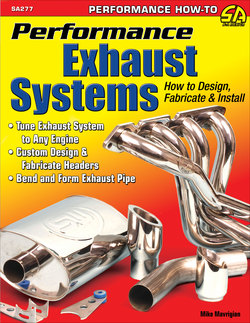Читать книгу Performance Exhaust Systems: How to Design, Fabricate, and Install - Mike Mavrigian - Страница 3
На сайте Литреса книга снята с продажи.
ОглавлениеCarTech®
CarTech®, Inc.
39966 Grand Avenue
North Branch, MN 55056
Phone: 651-277-1200 or 800-551-4754
Fax: 651-277-1203
www.cartechbooks.com
© 2014 by Mike Mavrigian
All rights reserved. No part of this publication may be reproduced or utilized in any form or by any means, electronic or mechanical, including photocopying, recording, or by any information storage and retrieval system, without prior permission from the Publisher. All text, photographs, and artwork are the property of the Author unless otherwise noted or credited.
The information in this work is true and complete to the best of our knowledge. However, all information is presented without any guarantee on the part of the Author or Publisher, who also disclaim any liability incurred in connection with the use of the information and any implied warranties of merchantability or fitness for a particular purpose. Readers are responsible for taking suitable and appropriate safety measures when performing any of the operations or activities described in this work.
All trademarks, trade names, model names and numbers, and other product designations referred to herein are the property of their respective owners and are used solely for identification purposes. This work is a publication of CarTech, Inc., and has not been licensed, approved, sponsored, or endorsed by any other person or entity. The Publisher is not associated with any product, service, or vendor mentioned in this book, and does not endorse the products or services of any vendor mentioned in this book.
Edit by Paul Johnson
Layout by Monica Seiberlich
ISBN 978-1-61325-207-9
Item No. SA334
Title Page: In order to avoid appearance issues and to increase system longevity, either ceramic-coated system components or using a 100-percent stainless steel system is required. The only thing to consider is that a ceramic coating protects the exterior of the pipes, but long-term corrosion on the inside of the pipes can take place. A high-grade stainless steel pipe provides anti-corrosion protection on both inside and outside walls.
Back Cover Photos
Top Left: Top-quality exhaust pipe manufacturers take the time to develop locating jigs for the placement of hanger rods to precisely match OEM fit. While cheap offshore pipes may or may not fit properly, leading U.S. exhaust pipe makers strive to produce pipes that exactly match the OEM designs.
Top Right: Merge crossovers are precision cut for flow, then carefully TIG welded to seal all seams. This results in a smooth flow transition with minimal exhaust flow turbulence, in contrast to a straight balance pipe that’s welded at 90 degrees to the main pipes.
Middle Left: When a slip joint is fabricated, the end needs to be expanded. In this photo, a 3-inch pipe’s end has been expanded to allow a slip-fit to a muffler that features a 3-inch entry pipe stub.
Middle Right: A timesaving approach to header prototype design is to tack weld and assemble a series of tube sections in a specific vehicle, rather than use the time-consuming task of making numerous test bends.
Bottom Left: Once the primary tubes for a specific application have been bent to shape and cut to length, the individual tubes are assembled in a welding jig that holds the tubes in place at the flange and grouped to achieve the proper arrangement.
Bottom Right: This bank was mocked up using plastic blocks. Shown here is one metal primary tube that was replicated using the modeling blocks, clamped together, and tack welded. The collector is attached, keeping tubes in the correct location. (Photo Courtesy Icengineworks)
